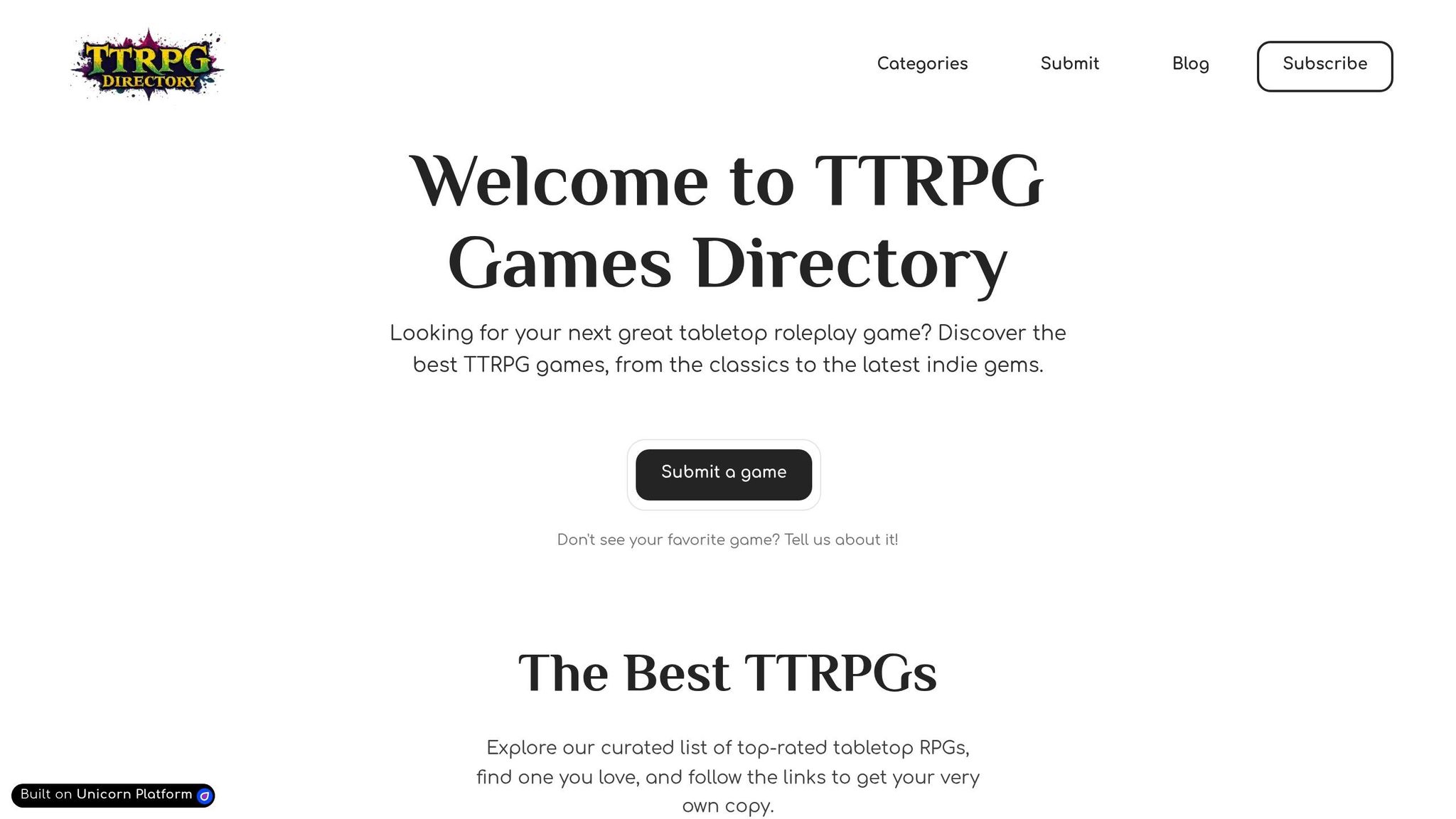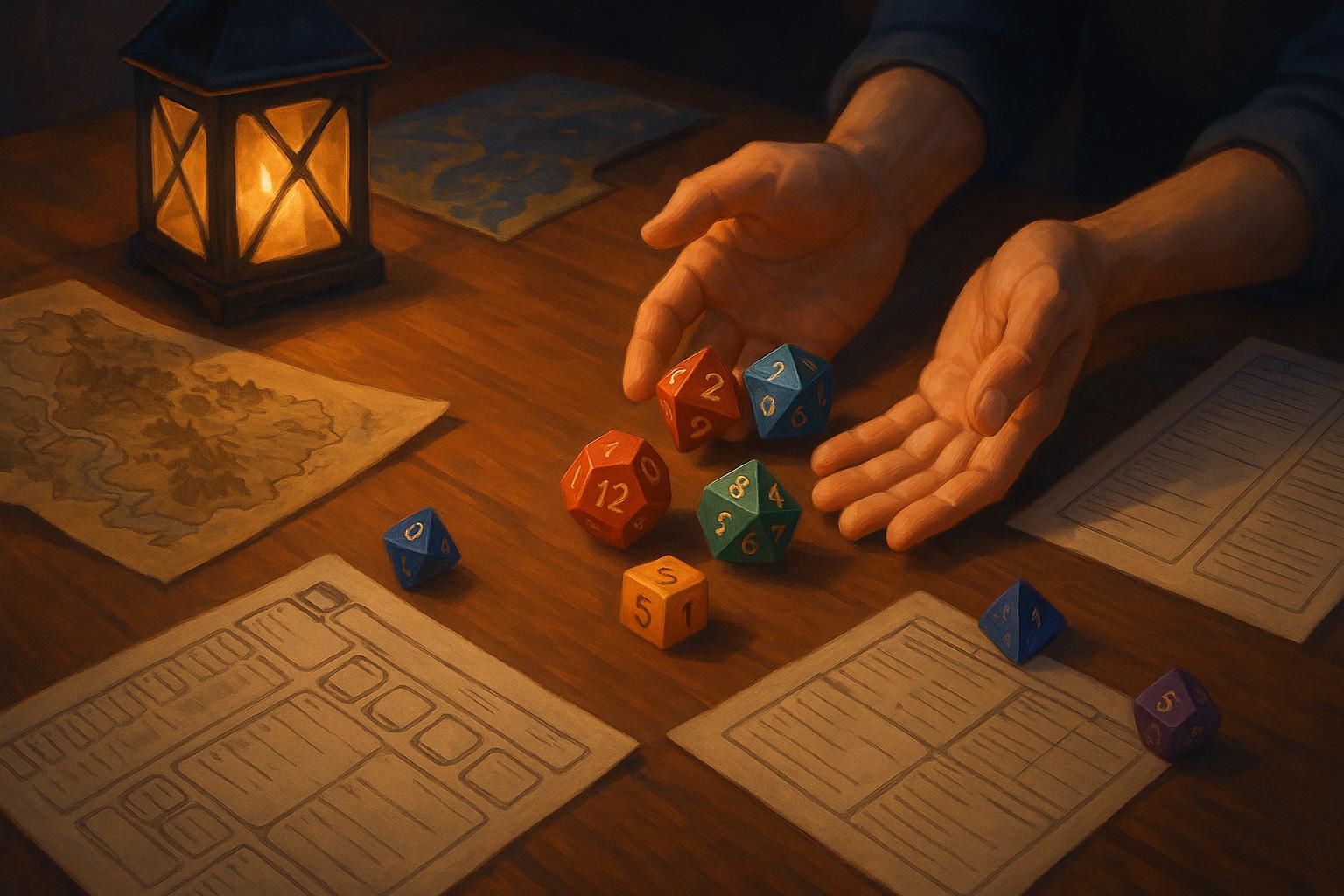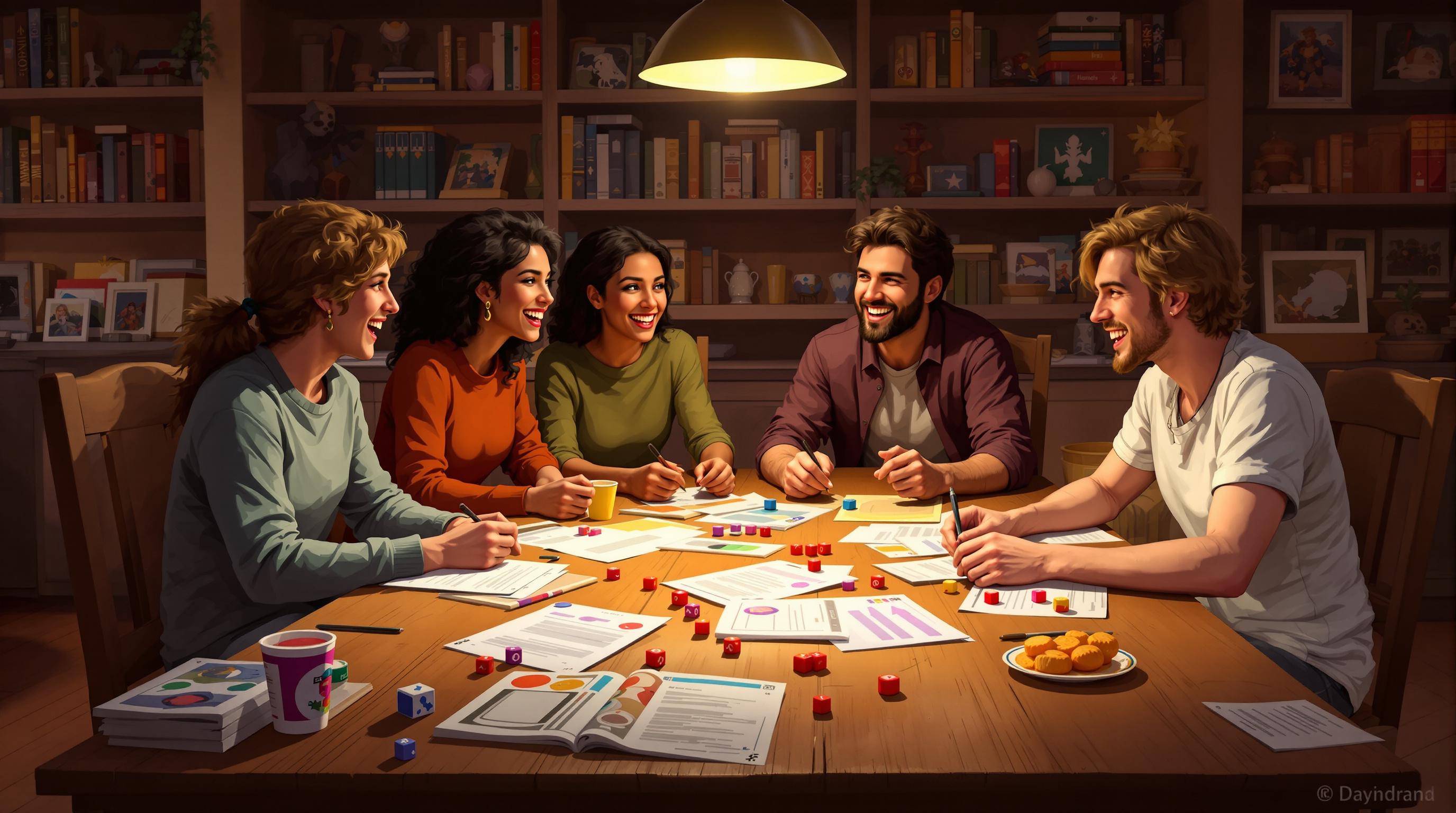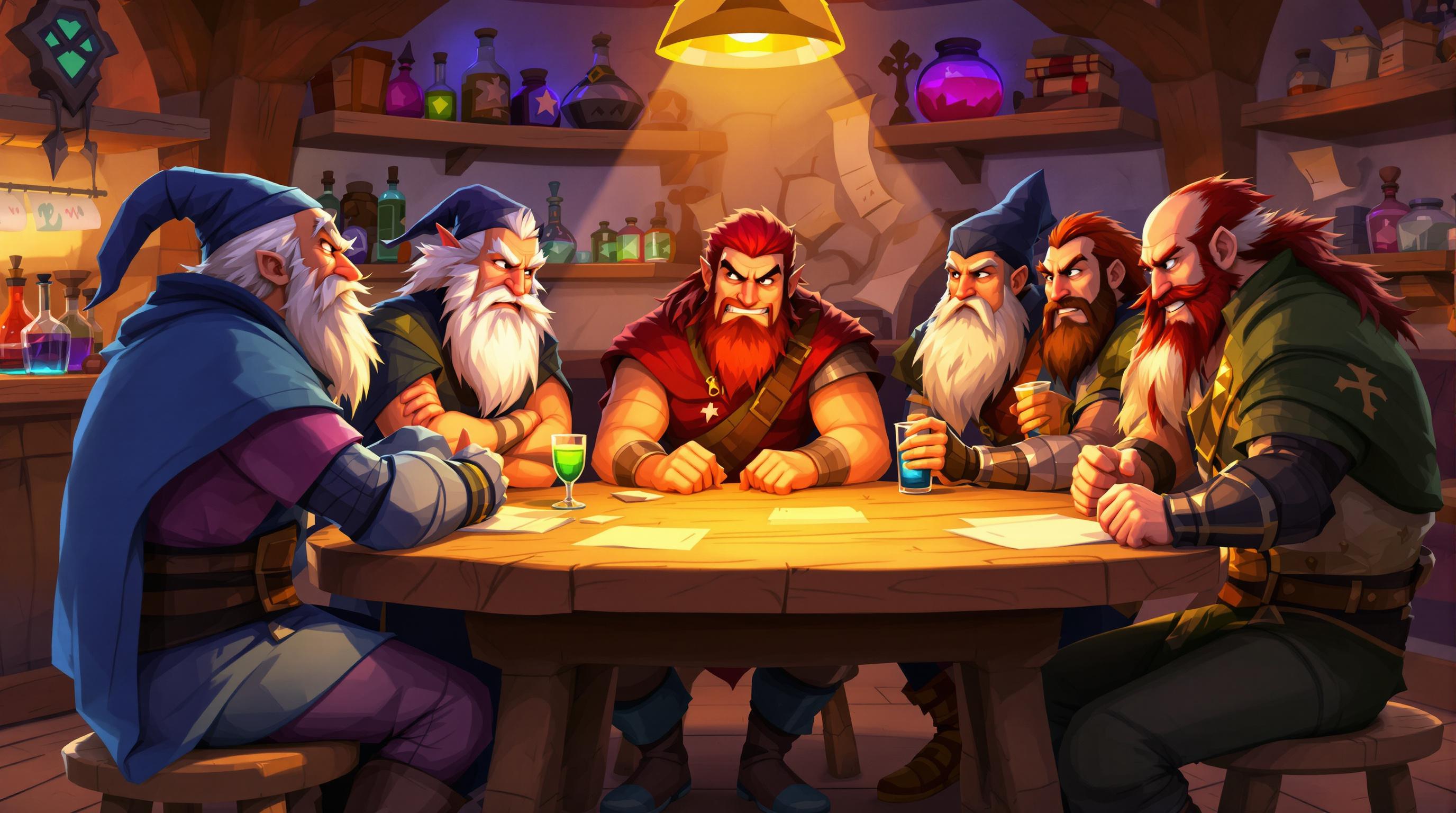Want to make your RPG sessions more engaging for everyone at the table? Shared narrative control lets players and Game Masters (GMs) collaborate to shape the story together, rather than relying solely on the GM. Here's what you need to know:
- What is it? Narrative control refers to deciding what happens in the story. Traditionally, the GM handles this. In shared control, players contribute to outcomes, world-building, and even scene setups.
- Why try it? It increases player engagement, reduces the GM's workload, and creates a more dynamic group storytelling experience.
- Techniques: Players can narrate successes, failures, or propose scene settings. Collaborative world-building and tools like "Yes, and..." keep the story moving.
- Challenges: Be mindful of uneven contributions, conflicting ideas, or losing focus. Clear boundaries and structured mechanics help avoid these pitfalls.
- Best systems for this: Games like Fiasco, Microscope, or Houses of the Blooded are designed for shared storytelling.
Want to dive deeper? Start small with techniques like failure narration or scene framing, and use systems that encourage shared storytelling. The right tools and open communication can make your sessions more rewarding for everyone.
Give Players Narrative Control?
Core Techniques for Sharing Narrative Authority
Shifting from a GM-driven approach to shared narrative control involves techniques that let players take a more active role without losing the story's structure. Let’s dive into methods that balance player contributions with the overall narrative flow.
Player-Directed Scene Outcomes
In this technique, players take charge of describing the outcomes of their actions. Instead of the GM detailing every result after a dice roll, players narrate what happens - whether it’s a success or a failure. For example, a player might describe a precise sword strike or explain how they stumble on loose stones when a roll goes poorly. While players shape the immediate details, the GM still oversees the larger plot and its consequences. This approach allows players to infuse their characters’ personalities, fighting styles, and emotions into the story, making their successes and failures feel more personal.
Collaborative World-Building
Collaborative world-building invites players to help shape the game’s setting and lore. Instead of the GM designing every detail, players contribute ideas about locations, landmarks, or even NPCs. For instance, when entering a new town, the GM might ask, "What’s the first thing you notice here?" or "What does the marketplace smell like?" Players can also tie their characters’ backstories into the world, perhaps by mentioning a gruff mentor or a unique local feature. These contributions not only enrich the setting but also make the world feel more connected to the characters, all while the GM integrates these ideas into the broader narrative.
Failure Narration and Scene Framing
Continuing the theme of shared storytelling, failure narration gives players the chance to turn setbacks into compelling story moments. For example, if a roll fails, the GM might ask, "What went wrong?" A player could respond, "My tools are too worn out to work properly." This approach transforms failure into an opportunity for creativity and character development.
Scene framing adds another layer of collaboration by letting players help shape the context of encounters. They might suggest where a scene takes place, which NPCs are involved, or even the mood of the event. For example, a player could propose, "Let’s confront the corrupt mayor during the harvest festival, where everyone can see what happens." Whether through rotating responsibilities or structured prompts, this method relies on clear communication and agreed-upon boundaries to keep the story cohesive and avoid conflicting elements.
These techniques create a foundation for blending player input with a well-structured narrative, ensuring everyone has a hand in shaping the story.
Balancing Input and Maintaining Story Flow
Keeping a story engaging while allowing players to flex their creativity is no small feat. It’s all about striking the right balance between giving players freedom and maintaining a cohesive narrative. Let’s explore how the GM’s role and game mechanics can help achieve this harmony.
The Role of the GM as a Steward
When players share in shaping the story, the GM takes on the role of a steward - someone who guides the narrative without controlling every detail. This involves aligning player ideas with the tone, themes, and direction of the story, ensuring creativity flourishes within the established framework.
A steward GM listens carefully to player ideas and finds ways to incorporate them into the story. If a player’s suggestion doesn’t quite fit, the GM doesn’t dismiss it outright. Instead, they collaborate with the player to tweak the idea so it works within the context of the game. For instance, in a low-fantasy setting, a player might propose a magical solution. Rather than rejecting it, the GM could suggest a more grounded alternative that serves the same purpose.
The GM also ensures the story stays thematically consistent. When a contribution risks clashing with the established mood or setting, the GM can gently redirect it. This isn’t about shutting down creativity - it’s about channeling it in a way that enhances the shared vision. Regular check-ins during the session can help everyone stay on the same page while ensuring players feel heard and valued.
Using Systems and Mechanics to Regulate Input
Game mechanics can provide a structured way to manage player contributions, ensuring creativity doesn’t spiral out of control. Tools like Fate points and narrative tokens are particularly effective for this.
In games like Fate, players spend points to introduce new story elements or influence outcomes. This creates natural boundaries, giving players opportunities to shape the story while preventing them from overwhelming it. Similarly, Houses of the Blooded lets the winner of a conflict narrate the outcome, even if it means their own character doesn’t come out on top. This approach prioritizes storytelling over individual success.
Powered by the Apocalypse games use structured moves to define when players gain narrative control. These moves create predictable moments for shared storytelling while leaving the GM in charge of framing scenes and managing consequences. By clearly outlining when and how players can contribute, these systems maintain order without stifling creativity.
These mechanics work because they set clear boundaries. Players know when they can step in and what kinds of contributions are appropriate, while the GM retains the ability to guide the story’s overall direction. This balance ensures that creativity and coherence go hand in hand.
Avoiding Common Pitfalls
Shared storytelling isn’t without its challenges. One common issue is narrative drift, where player contributions pull the story in too many directions, causing it to lose focus. This often happens when ideas aren’t tied back to the main plot or character goals.
Player conflicts over creative control can also disrupt sessions. Some players might dominate the narrative, while others hesitate to speak up, creating an imbalance. Another issue, sometimes called the "conch-passing" problem, arises when players take turns narrating without advancing the story in a meaningful way.
To avoid these pitfalls, establish clear expectations during session zero. Group discussions and majority votes can help set the tone for how the game will run. Tools like the X-card can manage sensitive content, ensuring everyone feels comfortable. Regular session recaps and reminders of key themes can help keep the story grounded. Starting each session with a quick summary of objectives can also focus contributions and prevent narrative drift.
When issues arise, address them directly. Open communication and group check-ins are essential for resolving conflicts before they escalate. Fostering a culture of respect and constructive feedback can turn potential disruptions into opportunities for growth, keeping your shared storytelling experience on track.
sbb-itb-b8b00a5
Dynamic Scene Co-Creation Techniques
Bringing scenes to life in real-time requires methods that keep everyone engaged while driving the story forward. These approaches turn static moments into dynamic, shared storytelling experiences.
Moment-to-Moment Collaboration
The "Yes, and..." technique is a cornerstone of improvisational storytelling in RPGs. This method encourages players and GMs to accept each other's ideas and build on them, creating a seamless flow of creativity. For example, if a player suggests their character notices something strange in a tavern, the GM might respond with, "Yes, and you also overhear hushed whispers about missing merchants." This keeps the story moving while sparking new directions for the narrative to explore.
Another effective technique is conch-passing, where narrative control shifts naturally between participants. One player might describe entering a shadowy library, another might elaborate on the eerie books they discover, and the GM could step in to introduce a sudden, mysterious encounter. This method works particularly well in systems like Fate, where players can use fate points to add new elements to the game world on the fly.
Active listening is crucial for keeping scenes cohesive. When someone adds details about a character’s emotions or the environment, others should weave those elements into their contributions. This creates a scene that feels like a collaborative effort rather than disconnected fragments.
These improvisational techniques are just the beginning. Tailoring them to suit individual player styles can make the experience even more engaging.
Adjusting for Player Preferences
Not every group thrives on the same approach, so it’s important to adapt techniques to match your players’ preferences. Some players respond well to clear prompts like, "What does your character’s final move look like?" or "What unexpected complication arises from your failure?" These focused questions provide structure while still inviting creativity.
For players who enjoy open-ended collaboration, broader prompts like, "Describe this location", or "Who might we encounter here?" give them the freedom to take the narrative in new directions without feeling constrained.
Experienced players accustomed to traditional GM-led games may need time to adjust to collaborative techniques. Start small by asking them to describe their character’s actions in more detail, then gradually encourage them to add environmental elements or NPC reactions. Offering positive feedback can help build their confidence and ease the transition.
Pay attention to how players react to creative control. Some thrive when given more authority, while others may seem hesitant or unsure. Adjust your approach accordingly - offer more structure to those who need it and more freedom to those who embrace it. The goal is to make sure everyone feels comfortable contributing in a way that suits them.
Comparing Co-Creation Methods
Once you’ve adjusted your techniques, comparing the various methods can help you determine what works best for your group.
| Co-Creation Method | Engagement Level | Story Depth | Drawbacks |
|---|---|---|---|
| Player narrates successes | Moderate | Moderate | Can feel repetitive if overused |
| Player narrates failures | High | High | May make some players uncomfortable |
| Collaborative worldbuilding | High | Very High | Risk of inconsistent storytelling |
| "Yes, and..." improvisation | High | High | Can lead to a loss of narrative focus |
| GM retains most control | Low | Variable | Reduces player investment |
Player-narrated successes are great for boosting confidence and involvement, but they can become predictable if used too often. On the other hand, failure narration often leads to more creative and unexpected outcomes, though it can feel intimidating for some players.
Collaborative worldbuilding fosters deep engagement by letting everyone shape the game world, but it requires careful oversight to avoid inconsistencies. The "Yes, and..." method promotes high energy and spontaneous story twists, but it relies on strong communication to keep the narrative on track.
Some systems, like Dust Devils and One-Shot World, make shared narration a core gameplay element, which helps co-creation feel natural rather than forced.
When deciding on techniques, consider your group’s experience, comfort level with improvisation, and preference for structure versus freedom. Choosing systems that support co-creation, as noted in the TTRPG Games Directory, can help reinforce shared storytelling throughout your campaign.
Choosing RPG Systems That Support Collaborative Storytelling
Picking the right system can shape your group's collaborative storytelling experience. While player dynamics and creative techniques matter, the game mechanics play a huge role in either encouraging or hindering shared narrative control. Systems designed with collaborative storytelling in mind make it easier for players to contribute without disrupting the flow. Below, we’ll dive into some standout systems and tools that incorporate these elements directly into their rules.
Systems That Emphasize Shared Storytelling
Fiasco is a prime example of a system built for collaboration. Its scene-framing mechanics rotate narrative control among players, ensuring everyone has a chance to shape the story. This structure prevents any single player from taking over, keeping the storytelling balanced and engaging.
Microscope takes collaboration in a different direction by focusing on world-building. Players work together to create a timeline, zooming in and out of different historical moments as they choose. This approach gives every participant equal say in shaping the world, resulting in a rich, collectively imagined setting.
Houses of the Blooded introduces a unique conflict resolution system where the outcome not only determines success or failure but also decides who gets to narrate the scene. Even a failed action can lead to exciting storytelling, as players gain the opportunity to steer the narrative in new directions.
These systems formalize collaborative storytelling through mechanics like narrative tokens, which let players introduce new elements, and scene-framing, which rotates the responsibility for setting up scenarios. Unlike traditional RPGs, these systems embed shared storytelling into their core, allowing players to contribute seamlessly without needing prior approval from the group.
Using the TTRPG Games Directory

Finding a system that fits your group's collaborative goals can be daunting, but the TTRPG Games Directory simplifies the process by offering detailed insights into each game's mechanics and narrative approach.
This directory provides clear descriptions of how different games handle player agency and shared storytelling. Instead of guessing which systems might work, you can use it to identify games with specific mechanics for distributing narrative authority. This saves time and helps you avoid choosing a system that doesn’t align with your group’s preferences.
You can search by genre - whether you’re into Fantasy, Science Fiction, Horror, or Cyberpunk - to find systems that combine your favorite themes with collaborative mechanics. Indie games, in particular, have embraced shared storytelling, reflecting the growing demand for player-driven narratives.
The directory also features a weekly newsletter to keep you updated on newly added games. As the collaborative storytelling space continues to grow, staying informed about the latest releases can help you discover systems that are perfect for your group.
When browsing the directory, look for terms like narrative tokens, scene-framing, shared world-building, or player-driven resolution. These keywords indicate that a game is designed with collaboration at its core, rather than treating it as an optional feature.
Ultimately, the TTRPG Games Directory is more than just a list - it’s a resource to help you make informed choices. By offering detailed breakdowns of each game’s mechanics and narrative features, it ensures you can find a system that aligns with your group’s storytelling style and preferences for shared narrative control.
Conclusion: Mastering Shared Narrative Control
Shared narrative control transforms RPGs into collaborative storytelling adventures. By distributing narrative authority among all players, you create a space where everyone feels more connected to the game. Players become deeply involved in shaping the story, while GMs can shift from being the sole storyteller to a guide who nurtures the group's creativity.
If you're new to this approach, start small. Invite players to describe how their characters succeed in combat or narrate the consequences of their failures. As your group becomes more comfortable, you can gradually expand the level of shared control. The GM's role naturally evolves into that of a facilitator, ensuring the story remains cohesive while encouraging collaboration.
Open communication and clear expectations are essential for success. Groups that embrace shared narrative control often experience stronger bonds, more dynamic storytelling, and a deeper sense of satisfaction. Players start caring not just about their own characters, but about each other's journeys and the world you're building together.
For those eager to explore systems designed for collaborative storytelling, the TTRPG Games Directory is a great resource. Look for games that incorporate mechanics like narrative tokens, scene-framing, or shared world-building. These tools make it easier to integrate shared narrative techniques, helping the process feel organic and enjoyable.
Don’t be afraid to experiment with shared narrative control, even if it feels unfamiliar at first. Try it out with low-stakes one-shots to practice, and take time after sessions to reflect with your group on what worked. The collective imagination at your table holds the potential for stories far richer than any single person could create alone.
FAQs
How can I help players feel more comfortable with sharing narrative control in RPGs?
Encouraging hesitant players to step into narrative control during RPG sessions starts with fostering a welcoming and collaborative atmosphere. Let them know that storytelling in these games is a group effort, and their input can make the experience richer for everyone. Emphasize that there's no need to aim for perfection - improvisation is part of what makes it so enjoyable!
To help them ease into the role, offer small, low-pressure opportunities to participate. For example, they could describe a minor NPC's appearance or suggest a detail about the setting. As they become more comfortable, they might naturally take on bigger storytelling responsibilities. Be sure to acknowledge their efforts and give encouraging feedback - it can go a long way in building their confidence.
How can players and GMs work together to keep the story consistent in a tabletop RPG?
To keep a tabletop RPG story flowing smoothly when multiple players are shaping the narrative, communication and teamwork are absolutely essential. Begin by establishing clear expectations during a session zero or early in the campaign. Use this time to discuss the tone, themes, and boundaries of the story. This way, everyone knows the kind of story you're aiming to tell, ensuring contributions feel cohesive and purposeful.
Active listening is another crucial element. Both players and the GM should focus on building off each other's ideas rather than vying for control. A great technique for this is the "Yes, and..." rule borrowed from improv. It helps keep the momentum going and fosters a sense of collaboration. The GM, meanwhile, can act as a subtle guide, gently steering the narrative to maintain focus while still leaving plenty of space for player creativity to shine.
For those seeking fresh ideas or systems that prioritize shared storytelling, the TTRPG Games Directory is a fantastic resource. It features a curated selection of tabletop RPGs, including some that are specifically designed to encourage collaborative narratives. Exploring these options could help you discover a system that perfectly matches your group's style of play.
How can I resolve creative disagreements between players during collaborative storytelling in RPGs?
Conflicts over creative ideas are a natural part of shared storytelling, but they don't have to derail the experience. The key is clear communication and a willingness to collaborate. Start by creating space for an open discussion where everyone can share their thoughts and perspectives. The aim should be finding a middle ground that honors the group's shared vision for the story while giving individual creativity room to thrive.
Setting ground rules or a shared framework before diving into the game can also make a big difference. This might involve agreeing on the story's tone, themes, or how much influence players will have on its direction. If tensions arise, the GM can step in as a neutral mediator, helping the group navigate disagreements and keep the narrative moving forward.
At the heart of it all is the goal of creating a fun, engaging experience for everyone at the table. By prioritizing teamwork and mutual respect, even conflicts can become opportunities to deepen the story and explore new layers of character development.


